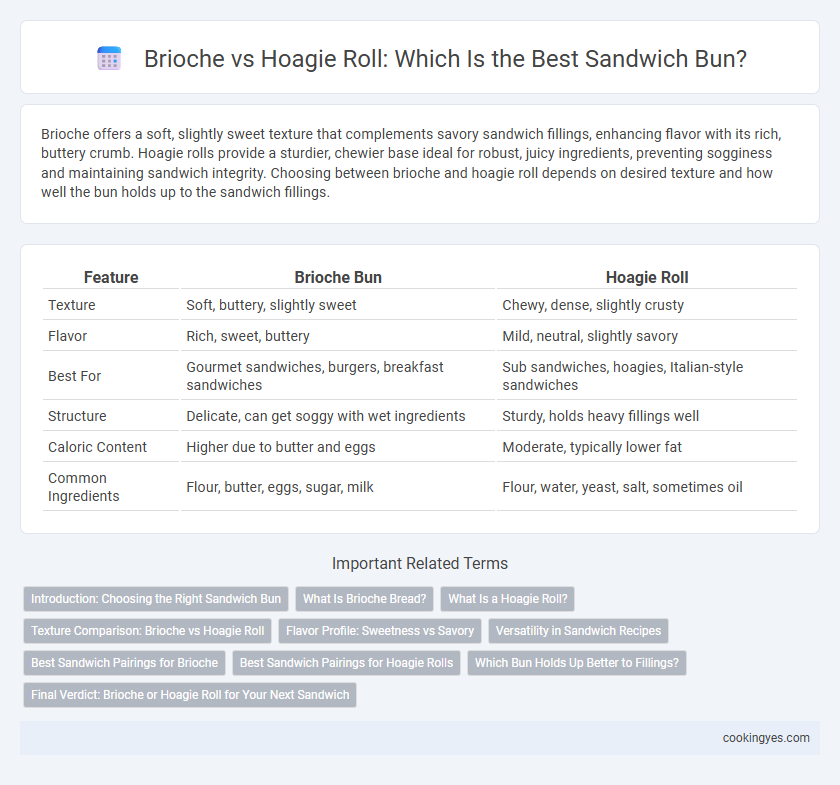Brioche offers a soft, slightly sweet texture that complements savory sandwich fillings, enhancing flavor with its rich, buttery crumb. Hoagie rolls provide a sturdier, chewier base ideal for robust, juicy ingredients, preventing sogginess and maintaining sandwich integrity. Choosing between brioche and hoagie roll depends on desired texture and how well the bun holds up to the sandwich fillings.
Table of Comparison
| Feature | Brioche Bun | Hoagie Roll |
|---|---|---|
| Texture | Soft, buttery, slightly sweet | Chewy, dense, slightly crusty |
| Flavor | Rich, sweet, buttery | Mild, neutral, slightly savory |
| Best For | Gourmet sandwiches, burgers, breakfast sandwiches | Sub sandwiches, hoagies, Italian-style sandwiches |
| Structure | Delicate, can get soggy with wet ingredients | Sturdy, holds heavy fillings well |
| Caloric Content | Higher due to butter and eggs | Moderate, typically lower fat |
| Common Ingredients | Flour, butter, eggs, sugar, milk | Flour, water, yeast, salt, sometimes oil |
Introduction: Choosing the Right Sandwich Bun
Brioche buns offer a soft, buttery texture with a slightly sweet flavor that complements rich or savory sandwich fillings, enhancing the overall taste experience. Hoagie rolls provide a sturdier, denser structure ideal for holding hearty ingredients without becoming soggy or falling apart. Selecting between brioche and hoagie roll depends on desired sandwich style, filling moisture level, and texture preference to achieve the perfect balance.
What Is Brioche Bread?
Brioche bread is a soft, slightly sweet French bread made with a high butter and egg content, resulting in a rich, tender crumb and golden crust ideal for gourmet sandwiches. Its subtle sweetness and fluffy texture contrast with the denser, chewier hoagie roll, which is traditionally used for heartier fillings like Italian cold cuts or cheesesteaks. Choosing brioche elevates sandwich flavor with a buttery nuance, making it perfect for upscale or breakfast-style sandwiches.
What Is a Hoagie Roll?
A hoagie roll is a long, soft sandwich bun with a slightly crusty exterior, traditionally used for hoagies, subs, and grinders. Its texture is sturdy enough to hold substantial fillings like deli meats, cheeses, and vegetables without becoming soggy. Compared to brioche, which is richer and sweeter due to its high butter and egg content, a hoagie roll offers a neutral flavor profile ideal for savory sandwich combinations.
Texture Comparison: Brioche vs Hoagie Roll
Brioche offers a soft, buttery texture with a slightly sweet crumb that enhances the flavor profile of sandwiches, making it ideal for rich or creamy fillings. Hoagie rolls feature a denser, chewier texture with a crustier exterior that holds up well to hearty, saucy ingredients without becoming soggy. The choice between brioche and hoagie roll depends on the desired mouthfeel and sandwich filling compatibility.
Flavor Profile: Sweetness vs Savory
Brioche buns offer a rich, buttery flavor with a subtle sweetness that enhances deli meats and grilled chicken in sandwiches. Hoagie rolls provide a denser, chewier texture with a savory taste that complements robust fillings like Italian cold cuts and roasted vegetables. Choosing between brioche and hoagie rolls depends on whether a sweeter or more savory bread base best suits the sandwich ingredients.
Versatility in Sandwich Recipes
Brioche buns offer a rich, slightly sweet flavor and soft texture that complement gourmet sandwiches with ingredients like smoked meats, creamy cheeses, and fresh greens. Hoagie rolls provide a sturdier, denser structure ideal for hearty fillings such as Italian cold cuts, grilled vegetables, and robust condiments, preventing sogginess in layered creations. The choice between brioche and hoagie rolls depends on the desired sandwich style, with brioche enhancing delicate, upscale flavors and hoagie rolls supporting substantial, rustic combinations.
Best Sandwich Pairings for Brioche
Brioche buns, with their rich, buttery texture and slightly sweet flavor, pair exceptionally well with savory fillings such as fried chicken, pulled pork, or gourmet burgers, enhancing each bite with a soft, tender contrast. Their delicate crumb complements sharp cheeses, caramelized onions, and spicy aioli, making them ideal for indulgent, flavor-packed sandwiches. Unlike hoagie rolls, which offer a chewier, denser structure suited for hearty deli meats and sub-style toppings, brioche elevates gourmet sandwich creations that benefit from a lighter, more decadent bun.
Best Sandwich Pairings for Hoagie Rolls
Hoagie rolls boast a sturdy yet soft texture ideal for holding hearty fillings like Italian cold cuts, meatballs, and Philly cheesesteaks without becoming soggy. Their slightly chewy crust complements robust ingredients such as provolone cheese, roasted peppers, and tangy giardiniera, making them the preferred choice for classic hoagie sandwiches. Unlike brioche, hoagie rolls offer a neutral flavor that lets savory meats and bold condiments shine in every bite.
Which Bun Holds Up Better to Fillings?
Brioche buns, with their soft and buttery texture, tend to absorb moisture quickly, which can lead to sogginess when loaded with juicy sandwich fillings. Hoagie rolls feature a denser crumb and sturdier crust, allowing them to hold up better against wet ingredients and heavier fillings without falling apart. For sandwiches with substantial or moisture-rich fillings, hoagie rolls offer superior durability and maintain structural integrity throughout consumption.
Final Verdict: Brioche or Hoagie Roll for Your Next Sandwich
Selecting between brioche and hoagie roll hinges on your sandwich's flavor profile and texture preferences. Brioche offers a rich, buttery softness that complements gourmet ingredients like roast beef or smoked turkey, enhancing each bite with its slightly sweet undertone. Hoagie rolls provide a denser, sturdier structure ideal for loaded sandwiches such as Italian subs, ensuring the fillings remain intact without overpowering the core flavors.
Brioche vs hoagie roll for sandwich bun Infographic

 cookingyes.com
cookingyes.com